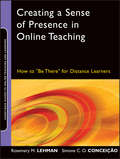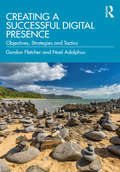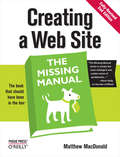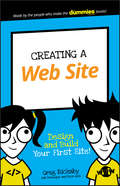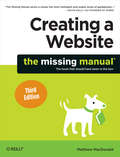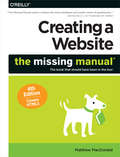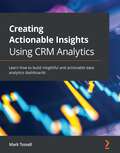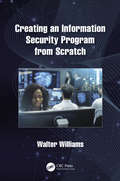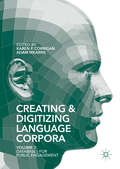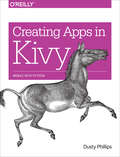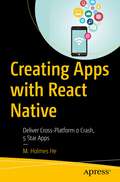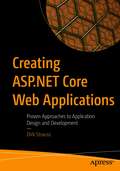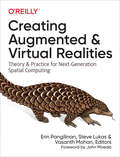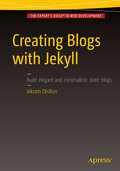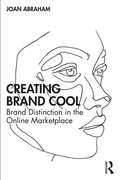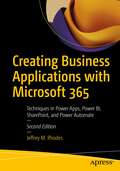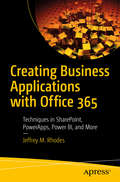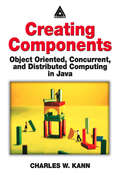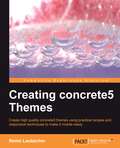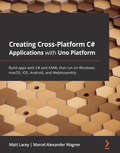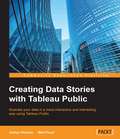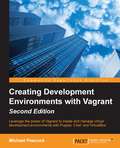- Table View
- List View
Creating a Roadmap Towards Circularity in the Built Environment (Springer Tracts in Civil Engineering)
by Luís Bragança Meri Cvetkovska Rand Askar Viorel UngureanuThis open access book summarizes the research being pursued as part of the COST Action CA21103 titled "Implementation of Circular Economy in the Built Environment" (Circular B), which aims to define the methodology to develop a common circularity framework for inclusive application and assessment in new and existing buildings to support decision-making for all value chain stakeholders and appraise the implementation level of the European Circular Economy Action Plan (CEAP). The Action is increasingly gaining interest worldwide, bringing multidisciplinary young and experienced researchers together to share the latest studies and develop new knowledge. Consisting of 17 chapters corresponding to the conference themes, the book analyses and discusses topics such as Circular Economy (CE) best practices, design strategies for circular buildings, circular materials and products, adaptive reuse of existing buildings, recovery and reuse of salvaged materials and products, case studies of current applications and trends, barriers against CE implementation in buildings, efficient waste and circular resource management, circular lifecycle management and decision making, stakeholders relationships, CE supporting policies and barriers, circular business models, criteria, KPIs and assessment models for circular buildings, CE criteria in sustainability frameworks, digitalization and BIM for enhanced circularity of buildings and building materials, and standardization of CE definitions in buildings.
Creating a Sense of Presence in Online Teaching
by Rosemary M. Lehman Simone C. ConceiçãoHow can faculty create a strong e presence for their online classes? This volume highlights the need for creating a presence in the online environment. The authors explore the emotional, psychological, and social aspects from both the instructor and student perspective. It provides an instructional design framework and shows how a strong presence contributes to effective teaching and learning. Filled with illustrative examples and based on research and experience, the book contains methods, case scenarios, and activities for creating, maintaining, and evaluating presence throughout the cycle of an online course.
Creating a Successful Digital Presence: Objectives, Strategies and Tactics
by Gordon Fletcher Noel AdolphusIncreasingly graduates, and anyone who is entering employment, need an individual digital presence to stand out and showcase themselves to secure their first professional role. This book takes an employability approach to encourage those currently studying, or about to enter the world of work, to develop a set of skills that enables them to recognise and deliver an effective digital presence, firstly for themselves and then for the organisations who would employ them. It does not assume any prior technical knowledge and emphasises the value and benefits of creating a presence to actively participate in the digital economy. By structuring the chapters incrementally, the reader is guided through the development of their own presence while also being given the concepts and tools that will enable them in the future to scale this activity to suit the needs of a startup, an SME or a social business. By using well-established business principles to design a strategy, the reader is guided through the creation of a personal Theory of Change that will enable them to turn an abstract goal into an individual digital presence through a defined series of stages and intermediate change objectives. The book then proposes a series of tactics to draw out concrete actions. A range of examples and case studies from around the world feature in each chapter to showcase the range of different types of digital presence that can be created. By using a strategic and systematic process, this book draws together academic thinking with tangible and highly practical outcomes. It is essential reading for advanced undergraduate and postgraduate students studying any discipline related to the digital world, particularly digital marketing and digital business, entrepreneurship and strategy, as well as those taking employability and personal professional development programmes.
Creating a Web Site: The Missing Manual (Missing Manual)
by Matthew MacdonaldThink you have to be a technical wizard to build a great web site? Think again. If you want to create an engaging web site, this thoroughly revised, completely updated edition of Creating a Web Site: The Missing Manual demystifies the process and provides tools, techniques, and expert guidance for developing a professional and reliable web presence.Whether you want to build a personal web site, an e-commerce site, a blog, or a web site for a specific occasion or promotion, this book gives you detailed instructions and clear-headed advice for:Everything from planning to launching. From picking and buying a domain name, choosing a Web hosting firm, building your site, and uploading the files to a web server, this book teaches you the nitty-gritty of creating your home on the Web.Ready-to-use building blocks. Creating your own web site doesn't mean you have to build everything from scratch. You'll learn how to incorporate loads of pre-built and freely available tools like interactive menus, PayPal shopping carts, Google ads, and Google Analytics. The modern Web. Today's best looking sites use powerful tools like Cascading Style Sheets (for sophisticated page layout), JavaScript (for rollover buttons and cascading menus), and video. This book doesn't treat these topics as fancy frills. From step one, you'll learn easy ways to create a powerful site with these tools.Blogs. Learn the basics behind the Web's most popular form of self-expression. And take a step-by-step tour through Blogger, the Google-run blogging service that will have you blogging before you close this book.This isn't just another dry, uninspired book on how to create a web site. Creating a Web Site: The Missing Manual is a witty and intelligent guide you need to make your ideas and vision a web reality.
Creating a Web Site: Design and Build Your First Site!
by Greg RickabySpeak to the world with your very own custom website! Creating a Web Site is the kids' guide to learning basic website design! From planning to perfecting, this book walks you through the entire process of building your own website, with easy-to-read instructions and plenty of pictures every step of the way. Good planning saves you a ton of work, so you'll begin by getting your ideas out of your head and onto paper. Next, you'll find a template that already has the basic features you want, so you can start working on the fun stuff right away. You'll learn all the HTML and CSS you need to make your site look and act the way you want it to, and you'll learn how to add video, images, widgets, and more to make the design your very own! Before you know it, you'll have your own custom-built website showcasing your talents and interests for the world. If you want your own website, why settle for a basic template that makes your page look like everyone else's? You don't need to build it from scratch—with a few simple lines of code, you can transform a basic template into the site of your dreams. This book shows you how to have fun from page one as you: Figure out just what kind of site you want to build Create a mood board to bring your ideas into reality Choose your favorite template and customize it with CSS and HTML Add widgets, pictures, video, and more to make your site your very own Easy instruction with a dose of humor have made the For Dummies books a leading resource for adults around the globe. The Dummies Junior series brings that learning to kids, with projects designed specifically for your interests, skills, and abilities. Creating a Web Site helps you build your digital home base, with fun instruction every step of the way.
Creating a Website: The Missing Manual
by Matthew MacdonaldThink you need an army of skilled programmers to build a website? Think again. With nothing more than an ordinary PC, some raw ambition, and this book, you’ll learn how to create and maintain a professional-looking, visitor-friendly site. This Missing Manual gives you all the tools, techniques, and expert advice you need.Plan your site. Create web pages by learning the basics of HTML and HTML5.Control page design with CSS. Format text, images, links, tables, and other elements.Attract visitors. Ensure that people can find your site through popular search engines.Build a community. Add forums, fresh content, and a feedback form to encourage repeat visits.Get smart. Use free tools to identify your site’s strengths and weaknesses.Create your own blog. Post your musings with a free blog-hosting service.Bring in cash. Host Google ads, sell Amazon’s wares, or push your own products.Add pizzazz. Include audio, video, interactive menus, and more.
Creating a Website: The Missing Manual
by Matthew MacdonaldYou can easily create a professional-looking website with nothing more than an ordinary computer and some raw ambition. Want to build a blog, sell products, create forums, or promote an event? No problem! This friendly, jargon-free book gives you the techniques, tools, and advice you need to build a site and get it up on the Web.The important stuff you need to know:Master the basics. Learn HTML5, the language of the Web.Design good-looking pages. Use styles to build polished layouts.Get it online. Find a reliable web host and pick a good web address.Use time-saving tools. Learn free tools for creating web pages and tracking your visitors.Attract visitors. Make sure people can find your site through popular search engines like Google.Build a community. Encourage repeat visits with social media.Bring in the cash. Host Google ads, sell Amazon's wares, or push your own products that people can buy via PayPal.Add pizzazz. Include audio, video, interactive menus, and a pinch of JavaScript.
Creating Actionable Insights Using Tableau CRM: Learn how to build insightful and actionable data analytics dashboards
by Mark TossellLeverage Tableau CRM to generate valuable business insights and solve business problems efficientlyKey FeaturesExtract, combine, transform, and visualize your data to derive business insights using Tableau CRMGain hands-on experience as you walk through practical dashboard use cases in Tableau CRMLearn how to build best-in-class dashboards from a Tableau CRM thought leaderBook DescriptionTableau CRM, formerly Einstein Analytics, is a powerful and versatile data analytics platform that enables organizations to extract, combine, transform, and visualize their data to create valuable business insights. Despite being a highly capable tool and in high demand in the industry, proficiency in Tableau CRM skills is hard to find.Creating Actionable Insights Using Tableau CRM provides a hands-on approach to Tableau CRM implementation and associated methodologies that will have you up and running and productive in no time. The book provides you with detailed explanations of essential concepts to help you to gain confidence and become competent in using the Tableau CRM platform for data extraction, combination, transformation, visualization, and action. As you make progress, you'll understand what Tableau CRM is and where it provides business value. You'll also learn how to bring your data together in Tableau CRM, build datasets and lenses for data analysis, create effective analytics dashboards for visualization and consumption by end users, and build dashboard actions that take the user from data to insight to action with ease.By the end of this Tableau book, you'll be able to solve business problems using Tableau CRM and design, build, test, and deploy Tableau CRM analytics dashboards efficiently.What you will learnImplement and configure Tableau CRM from scratchBuild your first Tableau CRM analytics app and embed your Tableau CRM dashboards in Salesforce to enhance user adoptionConnect Salesforce and external data with Tableau CRM and create datasetsCreate a data recipe and get familiar with the recipe UIBuild a custom dashboard in Tableau CRM using the dashboard editorUse lenses to create a Tableau CRM analytics dashboardConfigure and implement data security and governanceBuild configured record actions to automate data directly in SalesforceWho this book is forThis book is for data analysts, business analysts, BI professionals, and Salesforce users who want to explore Tableau CRM's capabilities and features. Basic knowledge of Salesforce and data analytics is assumed to get the most out of this book.
Creating an Information Security Program from Scratch
by Walter WilliamsThis book is written for the first security hire in an organization, either an individual moving into this role from within the organization or hired into the role. More and more, organizations are realizing that information security requires a dedicated team with leadership distinct from information technology, and often the people who are placed into those positions have no idea where to start or how to prioritize. There are many issues competing for their attention, standards that say do this or do that, laws, regulations, customer demands, and no guidance on what is actually effective. This book offers guidance on approaches that work for how you prioritize and build a comprehensive information security program that protects your organization. While most books targeted at information security professionals explore specific subjects with deep expertise, this book explores the depth and breadth of the field. Instead of exploring a technology such as cloud security or a technique such as risk analysis, this book places those into the larger context of how to meet an organization's needs, how to prioritize, and what success looks like. Guides to the maturation of practice are offered, along with pointers for each topic on where to go for an in-depth exploration of each topic. Unlike more typical books on information security that advocate a single perspective, this book explores competing perspectives with an eye to providing the pros and cons of the different approaches and the implications of choices on implementation and on maturity, as often a choice on an approach needs to change as an organization grows and matures.
Creating and Digitizing Language Corpora: Volume 3: Databases for Public Engagement
by Karen P. Corrigan Adam MearnsThis book unites a range of approaches to the collection and digitization of diverse language corpora. Its specific focus is on best practices identified in the exploitation of these resources in landmark impact initiatives across different parts of the globe. The development of increasingly accessible digital corpora has coincided with improvements in the standards governing the collection, encoding and archiving of 'Big Data'. Less attention has been paid to the importance of developing standards for enriching and preserving other types of corpus data, such as that which captures the nuances of regional dialects, for example. This book takes these best practices another step forward by addressing innovative methods for enhancing and exploiting specialized corpora so that they become accessible to wider audiences beyond the academy.
Creating and Managing a CRM Platform for your Organisation
by Richard BoultonMore than ever, organisations are facing a data avalanche from various sources, be they in electronic or hard copy format. How an organisation manages this ever-increasingly important resource – data – can benefit or hinder its ability to achieve its objectives. Creating and Managing a CRM Platform for Your Organisation not only covers how the principles of data management, including data quality and data security, can be applied to an organisation’s customer relationship management (CRM) platform, but also highlights how aspects of data management, marketing and technology are needed to operate, develop and manage a CRM platform in order to carry out tasks such as reporting and analysis, developing data plans, undertaking data audits, data migrations and campaign mailings which will result in an organisation using data effectively in order to achieve its goals and objectives. The issues and topics covered apply to all organisations that use a CRM platform and the data it contains as part of their business activities, regardless of the industry sector or size of the organisation. A comprehensive overview of the practices that can be effectively implemented when managing a CRM platform, this book is essential reading for professionals involved in the administration of the CRM platform within their organisation and data management.
Creating Apps in Kivy
by Dusty PhillipsBuild mobile apps efficiently with Kivy, the Python-powered graphical toolkit for creating natural user interfaces with elegant multitouch support. With this hands-on guide, you'll learn step-by-step how to build and deploy a complete Kivy app for iOS and Android devices. If you're just beginning to work with Python, but are reasonably familiar with its syntax, you're ready to go.Each chapter includes exercises, using examples that run on Python 3 and Python 2.7. Learn how Kivy simplifies mobile development with its cross-platform API and domain-specific Kv language, and why this free and open source toolkit is ideal for commercial products.Design custom widgets with the Kv languageDelve into Kivy events, event handlers, and propertiesDynamically change which Kivy widgets are displayedUnderstand and apply iterative development principlesCreate basic animations, using Canvas and graphics primitivesStore local data with Kivy's powerful key value storeAdd basic gestures to switch between app viewsImprove your app's usability with Kivy's built-in widgetsDeploy the app to your Android or iOS device, using Buildozer
Creating Apps with React Native: Deliver Cross-Platform 0 Crash, 5 Star Apps
by M. Holmes HeProduce high-quality, cross-platform apps with user experiences almost identical to pure native apps. When evaluating cross-platform frameworks, developers make an assumption that quality will be compromised. But that doesn't have to be true. The principles in this book will show you how to meet quality expectations both from engineering and consumer standpoints. You’ll also realize the ideal of a greater front end. That means your whole front-end team, including app side and web side, will be optimized. The shared knowledge base as well as mobilization potential give more flexibility and strength in all front-end facets without the need of increasing team sizes.The market has seen a large amount of high quality React Native apps and successful stories about them. Nevertheless, under optimized apps and unsuccessful stories shadow. The fundamental difference between the two opposing groups is understanding. Discover the critical points in the React and React Native architecture, and develop general best practices that can lead to consistently developing 0 crash, 5 star apps based on an understanding of fundamentals.What You'll LearnMeasure and define successful app designCreate animation based on user needReduce performance bottleneck throughout your appsWho This Book Is ForMobile developers who want to expand their front end skill set, and web developers who want to enter mobile development.
Creating ASP.NET Core Web Applications: Proven Approaches to Application Design and Development
by Dirk StraussDesign and develop an ASP.NET Core web application using .NET Core 3.0. This book shows you how to publish a web application to a web server and connect the published web application to a production database.Creating ASP.NET Core Web Applications starts by setting up the Visual Studio project where you will learn about Razor pages, Entities, and creating a data service. You will create models along with methods to use a query string and handle bad requests. Modifying data with Tag helpers is discussed as well as installation of Entity Framework, working with database migrations, and implementing a data access service. You will learn how to use layout pages and sections with Partial Views, _ViewImports, and _ViewStart files. You also will create custom middleware and log application events. You will be able to deploy the web application as well as connect it to a SQL Server database.What You Will LearnWork with modelsModify dataWork with EF Core and SQL ServerWork with Razor pages and Partial ViewsUse separate scripts for production vs developmentTrace client-side errors using Chrome Developer toolsCreate cascading style sheets (CSS) with Sassy CSS (SCSS)Explore middlewareDeploy your web application to IISWho This Book Is ForSoftware developers on the .NET stack who want to create ASP.NET Core web applications
Creating Augmented and Virtual Realities: Theory and Practice for Next-Generation Spatial Computing
by Erin Pangilinan Steve Lukas Vasanth MohanDespite popular forays into augmented and virtual reality in recent years, spatial computing still sits on the cusp of mainstream use. Developers, artists, and designers looking to enter this field today have few places to turn for expert guidance. In this book, Erin Pangilinan, Steve Lukas, and Vasanth Mohan examine the AR and VR development pipeline and provide hands-on practice to help you hone your skills.Through step-by-step tutorials, you’ll learn how to build practical applications and experiences grounded in theory and backed by industry use cases. In each section of the book, industry specialists, including Timoni West, Victor Prisacariu, and Nicolas Meuleau, join the authors to explain the technology behind spatial computing.In three parts, this book covers:Art and design: Explore spatial computing and design interactions, human-centered interaction and sensory design, and content creation tools for digital artTechnical development: Examine differences between ARKit, ARCore, and spatial mapping-based systems; learn approaches to cross-platform development on head-mounted displaysUse cases: Learn how data and machine learning visualization and AI work in spatial computing, training, sports, health, and other enterprise applications
Creating Blogs with Jekyll
by Vikram DhillonLearn to create your own blog using the Jekyll static site generator. You'll start with a simple template, add new features to it, automate any maintenance, attach social sharing, and begin writing. By the end of Creating Blogs with Jekyll, you will be able to create custom blogs with Jekyll, update the content with ease, and reach out to your readers with minimal effort. Because you've built your blog yourself, you'll know exactly how each component works, and you won't be dependent on an admin panel to maintain it. Creating Blogs with Jekyll equips you with the knowledge to create an elegantly designed blog and scale it to capture more readers. Recapture the magic of writing by creating great content and use an easy workflow in Jekyll to maintain it for blogging. Do new things and write about them in style with Jekyll. Takes you through building a fully functional blog from scratch using Jekyll Provides a fun way to work on a side-project and integrate cutting edge web technologies Teaches you how to update and maintain your awesome blog Jekyll is a simple, secure and very low maintenance blog engine that converts naturally written content in markdown into a beautiful and minimal blog. It allows you to focus on content creation and expressing yourself instead of spending all your time updating the plugins and maintaining the database. Jekyll does not rely on a database as a backend so your blog will be far more secure and reliable than any traditional blogging engines such as WordPress. We live in a day and age where short attention spans make it very difficult to expose a reader to interesting content. What better way to capture a reader's attention and retain viewers by captivating them by your own unique style and taste? Jekyll allows the content to shine with minimal distractions and a greater focus on the content and easy sharing of the content. What you'll learn Choose a base theme appropriate for your style and development Integrate various web technologies that will work well together and enhance your blog Automate social sharing components and comments workflow Make adjustments to themes, views and styles of blog posts Update any of the modular components of the blog and integrate new technologies Implementing Jekyll and deploying static websites for future projects Who this book is for Creating Blogs with Jekyll is for the developer who is ready to move beyond the complexities of maintaining a content management system by creating their own unique blog in their own style. It's for the project manager tired of spending all their time editing their blog on the admin panel and updating the content management system. Creating Blogs with Jekyll is an excellent choice for new developers to start blogging because of the simplicity of Jekyll's theming layer and writing workflow. It's an excellent choice for the web developer wanting to build their blog from scratch and expand their knowledge of higher level web technologies.
Creating Brand Cool: Brand Distinction in the Online Marketplace
by Joan AbrahamIn this intriguing blend of branding how-to and business memoir, an industry pioneer presents the thought process and tools to create a successful Ecommerce business by developing a distinct emotional attraction to a brand, beyond individual product offerings. Leveraging her 26 years of experience in online marketing and branding, Joan Abraham reveals the thought process behind successfully addressing today’s marketing challenge: clearly defining the business’s brand essence using its owned social media channels to personalize the full character of the brand. Creating Brand Cool addresses the importance of developing a unique state of being that personally resonates with today’s consumer. Abraham energizes the creative and strategic thinking for attracting and maintaining brand loyalty when the competition is a click away. Appealing to branding and social media marketing professionals, as well as students in these fields, this book is a primer for building an online community and distinguishing a brand from the competition. It is relevant to all types of business, from small businesses to globally recognized brands.
Creating Business Applications with Microsoft 365: Techniques in Power Apps, Power BI, SharePoint, and Power Automate
by Jeffrey M. RhodesLearn how to automate processes, visualize your data, and improve productivity using Power Apps, Power Automate, Power BI, SharePoint, Forms, Teams, and more. This book will help you build complete solutions that often involve storing data in SharePoint, creating a front-end application in Power Apps or Forms, adding additional functionality with Power Automate, and effective reports and dashboards in Power BI. This new edition greatly expands the focus on Power Apps, Power BI, Power Automate, and Teams, along with SharePoint and Microsoft Forms. It starts with the basics of programming and shows how to build a simple email application in .NET, HTML/JavaScript, Power Apps on its own, and Power Apps and Power Automate in combination. It then covers how to connect Power Apps to SharePoint, create an approval process in Power Automate, visualize surveys in Power BI, and create your own survey solution with the combination of a number of Microsoft 365 tools. You’ll work with an extended example that shows how to use Power Apps and SharePoint together to create your own help ticketing system. This book offers a deep dive into Power BI, including working with JSON, XML, and Yes/No data, as well as visualizing learning data and using it to detect inconsistencies between Excel files. You’ll also see how to connect to Remedy and to the help system you will have created. Under author Jeffrey Rhodes’s guidance, you’ll delve into the Power Apps collection to learn how to avoid dreaded "delegation" issues with larger data sets. Back on applications, you will create a training class sign-up solution to only allow users to choose classes with available seats. Digging deeper into Teams, you’ll learn how to send chats, posts, and "adaptive cards" from Power Automate. Rounding things out, you’ll save Forms attachments to SharePoint with Power Automate, create your own "Employee Recognition" app with all of the Power Platform and Teams, add or edit weekly status reports, and learn how to create reservation and scoring applications. After reading the book, you will be able to build powerful applications using Power Apps, Power Automate, Power BI, SharePoint, Forms, and Teams. What You Will Learn Create productivity-enhancing applications with Power Apps, Power Automate, SharePoint, Forms, and/or TeamsTransform and visualize data with Power BI to include custom columns, measures, and pivotsAvoid delegation issues and tackle complicated Power Apps issues like complex columns, filtering, and ForAll loopsBuild scheduled or triggered Power Automate flows to schedule Teams Meetings, send emails, launch approvals, and much more Who This Book Is For Business and application developers.
Creating Business Applications with Office 365: Techniques in SharePoint, PowerApps, Power BI, and More
by Jeffrey M. RhodesTake your Office 365 and SharePoint projects to a higher level by using PowerApps, Flow, Power BI, JavaScript/jQuery jQuery UI widgets, Cascading Style Sheets (CSS), and more. This book will help you create easier solutions to client-side problems and applications. Additionally, you will be able to effectively visualize your data with Power BI.This book starts with configuration of SharePoint and Office 365 followed by your first example of PowerApps. You will lay the foundation for a help ticket application and see how to update a SharePoint list with PowerApps. You then will work with the jQuery open source library and learn how to use the developer tools within your browser. This allows you to customize data displays in SharePoint. Next, you will add jQuery UI widgets such as buttons and dialogs to SharePoint, learning how to configure and manipulate them via JavaScript. You will use these new skills to convert a normal SharePoint announcement into a visually compelling page of network alerts. You also will use JavaScript and styles to hugely improve native SharePoint calendars by color-coding them by category or location. To prevent overlapping events in calendars, you will work with SharePoint's web services and JavaScript. You will use similar concepts to make appealing accordion SharePoint pages. You then will explore Microsoft Forms, Flow, and Power BI, including building surveys in both Forms and SharePoint and using Power BI to show results over the last week, month, quarter, and year. Using advanced Power BI you will see how to deal with JSON, XML, and Yes/No data. Next, you will look at how to display Office documents as well as interact with them via JavaScript. Switching back to PowerApps, you will build the final help ticketing system before using Power BI to see how to visualize the ticket information. After a quick detour on using iFrames in SharePoint, you will jump into building a power routing application using InfoPath and SharePoint Designer. You will even call SharePoint’s web services from Designer to customize email notifications. You end the InfoPath set of chapters with a highly useful application for signing up for and managing attendance for training and other classes. Finally, you will add Google Analytics to track SharePoint usage.What You Will LearnBuild powerful applications with PowerAppsExtend SharePoint’s capabilities using JavaScript Create surveys with SharePoint and Microsoft Forms, copy the results to SharePoint using Flow, and visualize the data with Power BIEmploy advanced Power BI techniques to include custom columns, pivoting, and dealing with JSON, XML, and Yes/No dataUse InfoPath and SharePoint workflows to create routing systems, schedule classes, and other advanced tasksWho This Book Is ForBusiness and application developers
Creating Components: Object Oriented, Concurrent, and Distributed Computing in Java
by Charles W. KannConcurrency is a powerful technique for developing efficient and lightning- fast software. For instance, concurrency can be used in common applications such as online order processing to speed processing and ensure transaction reliability. However, mastering concurrency is one of the greatest challenges for both new and veteran programmers. Softwar
Creating Concrete5 Themes
by Remo LaubacherPractical guide to create Concrete5 themes.This book is great for theme developers new to concrete5 who are looking to use their experience in HTML and CSS to create high quality themes for concrete5. It's assumed that you have worked with HTML before and can also read code as you'll see some basic PHP and JavaScript code. There are a few words about using concrete5, but you're expected to spend a bit of time on your own to get familiar with the concrete5 interface by yourself and by reading some of the articles listed in the book. Readers are expected to have the ability to set up their own concrete5 site, but basic information about the installation and links to follow up are provided though.
Creating Cross-Platform C# Applications with Uno Platform: Build apps with C# and XAML that run on Windows, macOS, iOS, Android, and WebAssembly
by Matt Lacey Marcel Alexander WagnerDiscover how to leverage the Uno Platform to write single-codebase, cross-platform mobile, desktop, and web applications using C# and XAMLKey FeaturesEnhance your Windows apps by running them on all operating systems and browsersUse tools and APIs you already know to remain productive as you target new platformsCreate realistic apps for various lines of business (LOBs) and consumer scenariosBook DescriptionDevelopers are increasingly being asked to build native applications that run on multiple operating systems and in the browser. In the past, this would have meant learning new technologies and making multiple copies of an application. But the Uno Platform allows you to use tools, languages, and APIs you already know from building Windows apps to develop apps that can also run on other platforms. This book will help you to create customer-facing as well as line-of-business apps that can be used on the device, browser, or operating system of your choice.This practical guide enables developers to put their C# and XAML knowledge to work by writing cross-platform apps using the Uno Platform. Packed with tips and practical examples, this book will help you to build applications for common scenarios. You'll begin by learning about the Uno Platform through step-by-step explanations of essential concepts, before moving on to creating cross-platform apps for different lines of business. Throughout this book, you'll work with examples that will teach you how to combine your existing knowledge to manage common development environments and implement frequently needed functionality.By the end of this Uno development book, you will have learned how to write your own cross-platform apps with the Uno Platform and use additional tools and libraries to speed up your app development process.What you will learnUnderstand how and why Uno could be the right fit for your needsSet up your development environment for cross-platform app development with the Uno Platform and create your first Uno Platform appFind out how to create apps for different business scenariosDiscover how to combine technologies and controls to accelerate developmentGo beyond the basics and create 'world-ready' applicationsGain the confidence and experience to use Uno in your own projectsWho this book is forThis book is for developers who are familiar with app development for Windows and want to use their existing skills to build cross-platform apps. Basic knowledge of C# and XAML is required to get started with this book. Anyone with basic experience in app development using WPF, UWP, or WinUI will be able to learn how to create cross-platform applications with the Uno Platform.
Creating Data Stories with Tableau Public
by Matt Floyd Ashley OhmannThis book is targeted at investigative journalists and bloggers with an interest in making rich and interactive data visualizations. Intermediate Tableau Public users and organizations can also use this book as a reference guide and teaching aid. Members of the media team, such as data specialists, web developers, editors, producers, and managers can also benefit from an understanding of the structure and challenges of writing an interactive and interesting data visualization using Tableau Public.
Creating Development Environments with Vagrant
by Michael PeacockThis is a practical, hands-on guide that will help you set up and implement virtual development environments with Vagrant easily and effortlessly."Creating Development Environments with Vagrant" is for Vagrant developers, programmers, and coders who want to maintain multiple projects within their own environment. It is also aimed at companies who are looking to deploy ready-to-go development solutions for new staff or even existing staff moving to new projects, and to enforce a consistent and portable virtual development environment that is easy to create and quick to set up.
Creating Development Environments with Vagrant - Second Edition
by Michael PeacockIf you are a developer who wants to have your development environment accurately reflect your live servers to tackle the ever-increasing complexity of web and software projects, this book is most certainly intended for you! It's assumed that you know the basics of Linux systems in the context of web-based projects.

